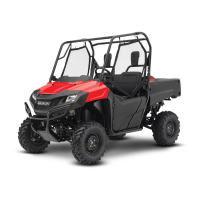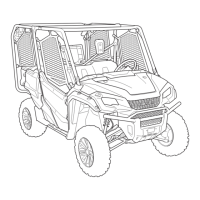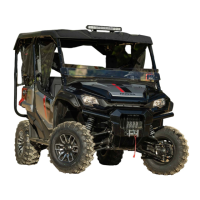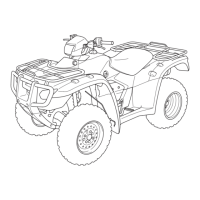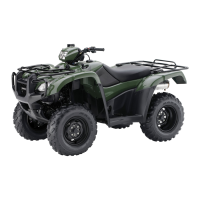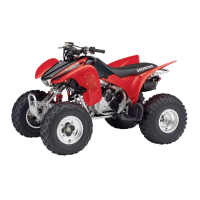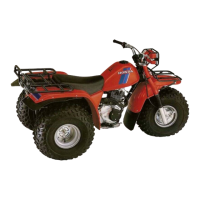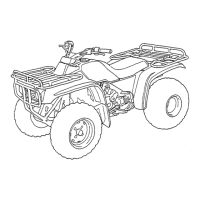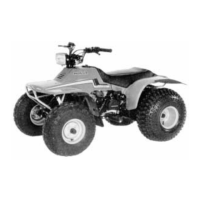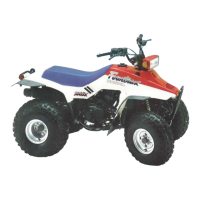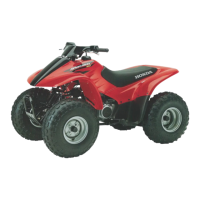
Do you have a question about the Honda Pioneer SXS500M 2018 and is the answer not in the manual?
| Brand | Honda |
|---|---|
| Model | Pioneer SXS500M 2018 |
| Category | Offroad Vehicle |
| Language | English |
Key safety recommendations for drivers and passengers.
Guidelines on using and modifying vehicle accessories.
Information on safety labels found on the vehicle.
Identification and location of vehicle controls and indicators.
Explanation of dashboard indicators and display functions.
Details on operating key vehicle controls like ignition and switches.
Guidance on driver readiness and essential checks before operating the vehicle.
Importance of pre-drive inspections and checks for vehicle readiness.
Guidelines and limits for safely loading cargo onto the vehicle.
Information on load limits and guidelines for towing a trailer.
Procedures for starting, stopping, and shifting gears in the vehicle.
Precautions and recommendations for safe vehicle operation in various conditions.
Essential information and safety precautions before starting vehicle maintenance.
Required maintenance intervals and tasks for vehicle upkeep.
Information on tools, component locations, and preparations for maintenance.
Recommended fuel type and octane rating for the vehicle.
Information on the vehicle's fuel tank capacity.
Step-by-step instructions for refueling the vehicle's fuel tank.
Recommended engine oil type, viscosity, and specifications.
Procedure for checking and adding engine oil to the vehicle.
Steps for draining engine oil and replacing the oil filter.
Recommended oil type and specifications for the front final gear.
Procedure for checking the front final gear oil level.
Steps for draining and refilling the front final gear oil.
Recommended oil type and specifications for the rear final gear.
Procedure for checking the rear final gear oil level.
Steps for draining and refilling the rear final gear oil.
Recommended coolant type and mixture for the cooling system.
Procedure for checking and adding coolant to the reserve tank.
Information on when and how coolant should be replaced.
Cleaning and checking the radiator core for obstructions.
Steps for removing, cleaning, and re-installing the air cleaner element.
Servicing and cleaning the air cleaner housing drain tube.
Locations and procedures for lubricating key vehicle pivots and joints.
Checking the accelerator pedal for proper freeplay and operation.
Procedure for adjusting the accelerator pedal freeplay.
Checking the reverse lever for smooth movement and proper selection.
Procedure for adjusting the reverse lever if necessary.
Recommended spark plug type and heat range for the engine.
Steps for inspecting and replacing spark plugs.
Checking the exhaust system for signs of gas leakage.
Adjusting front suspension spring pre-load for load and conditions.
Adjusting rear suspension spring pre-load for load and conditions.
General checks for fluid leaks and hose condition.
How to inspect brake pads for wear and when to replace them.
Checking the brake pedal for smooth operation and freeplay.
How to measure and adjust the parking brake lever freeplay.
Adjusting the brake light switch for proper operation.
Procedures for checking brake operation and visual inspection.
Recommended type of brake fluid and handling precautions.
How to check and maintain the brake fluid level.
Proper tire inflation for handling, tread life, and comfort.
Checking tires for bumps, cuts, foreign objects, and tread wear.
Checking tread depth and wear indicators for tire replacement.
Recommendations for repairing punctures and damaged tires.
Guidelines for replacing tires, including size and type recommendations.
Checking wheel nuts and for cracks or deformation.
Instructions for safely charging the vehicle's battery.
Information on the vehicle's battery type and care.
Procedures for storing the battery during extended periods.
Tips for cleaning and maintaining the vehicle's appearance.
Step-by-step guide for washing the vehicle with mild detergent.
Suggestions for using spray cleaners for different conditions.
How to clean mud and dust from the exhaust pipe and muffler.
Advice on planning and preparing for off-road drives.
Guidelines for safely transporting the vehicle on a trailer.
Procedures for preparing and storing the vehicle for extended periods.
Tips for environmentally responsible off-road driving.
General advice for dealing with problems encountered during driving.
Troubleshooting steps for engine starting and performance issues.
Troubleshooting steps if shift paddles are not working correctly.
Symptoms and actions for transmission shifting problems.
Procedure for manually selecting gears in emergencies.
Steps for handling a flat tire and wheel replacement.
Diagnosis and actions for high coolant temperature warnings.
Troubleshooting steps for blown fuses and electrical issues.
Safety priorities and checks after a vehicle crash.
Procedures for dealing with a lost ignition key.
Troubleshooting steps for a low or dead battery.
Advice for dealing with damaged vehicle components during driving.
Information on speed limitation due to seat belt status.
Information on VIN, engine serial number, and color label.
Technical data including dimensions, capacities, and engine specs.
Recommendations for the initial operating period of the vehicle.
Details on exhaust and evaporative emission control systems.
Information on using oxygenated fuels and their compatibility.
Guidance on using petrol containing alcohol in specific regions.
Information on the catalytic converter's function and maintenance.
List of available service manuals and guides for the vehicle.
Overview of the vehicle's limited and emission control system warranties.
Procedures for obtaining warranty service and dealer interaction.
Information on how to contact Honda for customer support and feedback.
Information on dealer services, parts, and sales support.
Information about the Honda Rider's Club and its local chapters.
Tips on maintenance to prevent expensive repairs.
Summary of initial and regular maintenance intervals.
Checklist of items to inspect before each drive.
Key information on fuel type, octane, and tank capacity.
Summary of engine oil recommendations and capacity.
Vehicle's maximum load capacity for operator, cargo, and accessories.
Specifications for recommended tire sizes.
Recommended cold tire pressures for front and rear tires.
Recommended spark plug type for the vehicle.
Recommended coolant type and mixture.
Specifications for main and circuit fuses.
Explanation of symbols used for vehicle controls.
